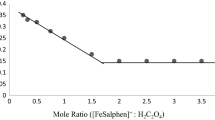Abstract
The kinetics of oxidation of the ternary complexes [CoII(ADA)(Su)(H2O)]2− and [CoII(ADA)(Ma)(H2O)]2− (ADA = N-(2-acetamido)iminodiacetate, Su = succinate and Ma = maleate) by periodate have been investigated spectrophotometrically at 580 nm under pseudo-first-order conditions in aqueous medium over 30–50 °C range, pH 3.72–4.99, and I = 0.2 mol dm−3. The kinetics of the oxidation of [CoII(ADA)(Su)(H2O)]2− obeyed the rate law d[CoIII]/dt = [CoII(ADA)(Su)(H2O)]2−[H5IO6] {k 4 K 5 + (k 5 K 6 K 2/[H+)}, and the kinetics oxidation of [CoII(ADA)(Ma)(H2O)]2− obeyed the rate law d[CoIII]/dt = k 1 K 2[CoII] T [IVII] T /{1 + ([H+]/K 7) + K 2[IVII] T }. The pseudo-first-order rate constant, k obs, increased with increasing pH, indicating that the hydroxo form of maleate complex, [CoII(ADA)(Ma)(OH)]3−, is the reactive species. The initial Co(III) products were slowly converted to the final products, fitting an inner-sphere mechanism. Thermodynamic activation parameters were calculated using the transition state theory equation. The initial cobalt(II) complexes were characterized by physicochemical and spectroscopic methods.








Similar content being viewed by others
References
Bocarly RJ, Barton JK (1992) Inorg Chem 1:2827
Farver O, Pecht I (1989) Coord Chem Rev 95:17
Sigel H, Mccormick DB (1970) Accounts Res 3:201
Norwak T, Mildvan AS, Kenyon GL (1973) Biochemistry 12:1960
Schray KJ, Mildvan AS (1972) J Biol Chem 247:2034
Robinson JD, Davis RL (1987) Biochim Biophys Acta 912:343
Cotton FA, Wilkinson G (1988) Advanced inorganic chemistry, 5th edn. Wiley, New York, p 569
Symons MCR (1955) J Chem Soc 2794
Galliford DJB, Ottaway JM (1972) Analyst 91:415
El-Ziri FR, Sulfab Y (1977) Inorg Chim Acta 25:15
Ali IH, Sulfab Y (2011) Inter J Chem Kinet 43:563
Abdel-Khalek AA (1989) Polyhedron 8:51
Ewais HA, Nagdy MA, Abdel-Khalek AA (2012) J OxidCoumm 35:00
Abdel-Khalek AA, Sayyah SM, Ewais HA (1997) Trans Met Chem 22:557
Khaled ESH (2007) Inorg React Mech 6:247
Ewais HA, Ahmed SA, Abdel-Khalek AA (2004) Inorg React Mech 5:125
Abdel-Hady AM (2000) Trans Met Chem 25:437
Abdel-Khalek AA, Mohamed AA, Ewais HA (1999) Trans Met Chem 24:233
Naik RM, Sarker J, Chaturvedi DD, Verma A, Singh SK (2003) Ind J Chem Sect A 42:1639
Naik RM, Srivastava A, Tiwari AK, Yadav SBS, Verma AK (2007) Iran Chem Soc 4:63
Hussein MA, Abdel-Khalek AA, Sulfab Y (1983) J Chem Soc, Dalton Trans 839:317
Abdel-Khalek AA, Khaled ESH, Mohamed RA (2007) J Coord Chem 61:152
Ewais HA (2008) Inter J Chem Kinet 40:103
Ewais HA (2009) J Coord Chem 62:940
Vogel AI (1961) Textbook of quantitative inorganic analysis, 3rd edn. Longmans, London, p 443
Hadinec I, Jensovsky L, Linek A, Synecek V (1960) Naturwiss 47:377
Ray P (1957) Inorg Synth 5:201
Crouthamel CE, Hayes AM, Martin DS (1951) J Am Chem Soc Jpn 73:82
Ewais HA, Habib MA, Elroby SA (2010) Trans Met Chem 35:73
Ewais HA, Shehata MR, Nagdy MA, Abdel-Khalek AA (2010) Inorg Chem Indian J 5:2
Weaver MJ, Yee EL (1980) Inorg Chem 19:1936
Mcardle JV, Coyle CL, Gray HB, Yoneda CS, Howerda RA (1977) J Am Chem Soc 99:2483
Holwerda RA, Clemmer JD (1979) Bioinorg Chem 11:7
Wherland S, Gray HB (1977) In: Dolphin D (ed) Biological aspects of inorganic chemistry. Wiley, New York, p 189
Bowden AC (2002) J Biosci 27:121
Author information
Authors and Affiliations
Corresponding author
Rights and permissions
About this article
Cite this article
Ewais, H.A., Nagdy, M.A.M. & Abdel-Khalek, A.A. Electron transfer mechanism for the oxidation of ternary N-(2-acetamido)iminodiacetatocobaltate(II) complexes involving succinate and maleate as secondary ligands by periodate. Transition Met Chem 37, 525–533 (2012). https://doi.org/10.1007/s11243-012-9618-z
Received:
Accepted:
Published:
Issue Date:
DOI: https://doi.org/10.1007/s11243-012-9618-z




